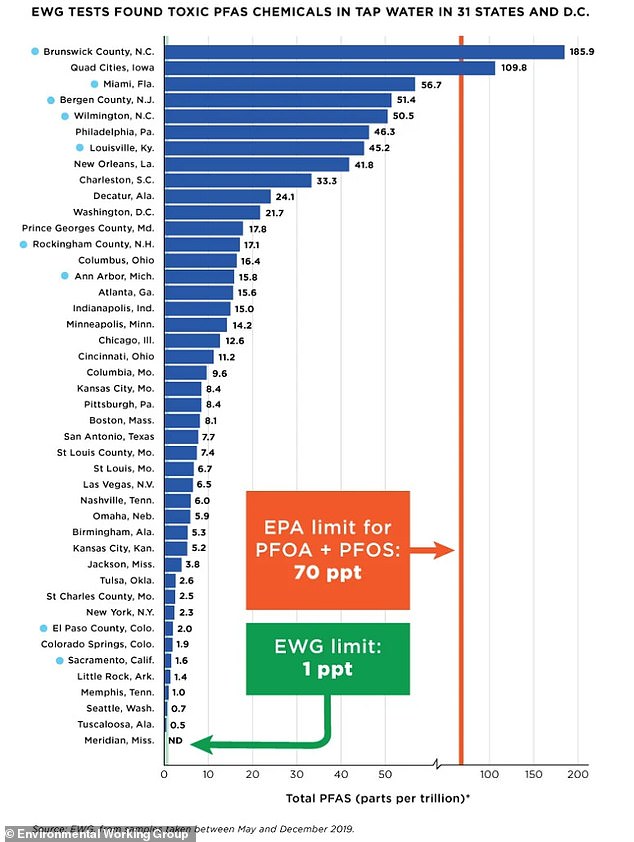Scientists urge people to lay off lobster and shrimp as study finds seafood is a major source of toxic forever chemicals linked to cancer
Those who like to indulge in sushi buffets or treat themselves to a lobster dinner should beware: they are at greater risk of exposure to toxic “forever chemicals.”
Although the chemicals are more commonly linked to household items and tap water, a new study has warned that seafood is also a source.
Researchers from Dartmouth College tested various types of seafood purchased at various locations in New Hampshire for 26 types of PFAS.
Sampling showed that shrimp and lobster contained dangerously high levels of PFAS.
Megan Romano, co-author of the Dartmouth study, said: ‘Our recommendation is not to avoid eating seafood; seafood is a great source of lean protein and omega fatty acids.
‘But it is also a potentially underestimated source of PFAS exposure in humans. Understanding this risk-benefit ratio in seafood consumption is important for people making dietary decisions, especially for vulnerable populations such as pregnant women and children.”
Researchers from Dartmouth tested seafood purchased at various locations in New Hampshire for 26 types of PFAS

2020 Environmental Working Group (EWG) data ranks Brunswick County, North Carolina, as the top region in the U.S. with PFAS in drinking water
PFAS are microscopic substances that take thousands of years to break down in the environment and the human body, earning them the name “forever chemicals.”
They are found in textiles, firefighting foam, nonstick cookware, clothing and food packaging and seep into the water supply, soil and air.
Because PFAS are found almost everywhere in the environment, the researchers said it was difficult to know where in the marine food chain the chemicals enter the fish.
There is no safe exposure to the chemicals, and a growing body of research links them to hundreds of cancers, infertility problems, fetal abnormalities and a host of other health problems, including autism.
For the study, researchers tested samples of cod, haddock, lobster, salmon, scallop, shrimp and tuna.
They then asked more than 1,800 New Hampshire residents what type of fish they ate and how often.
The study found that people living in the state consume more seafood than the national average, meaning they could be exposing themselves to PFAS and the health complications associated with the chemicals.
Although researchers did not test PFAS levels in respondents, a separate 2023 study found that Asian-Americans, who often eat diets high in seafood, had 89 percent higher levels of PFAS in their blood compared to other ethnicities.
That study said a diet high in seafood could be the cause, as fish is a major source of PFAS (per- and polyfluoroalkyl substances) contamination.
The Dartmouth researchers chose to focus on New Hampshire because the state, along with most of the New England region, eats more seafood than the average American, given its location and local fishing industry.
Ninety-five percent of adults surveyed reported eating seafood in the past 12 months. Of those, 94 percent consumed fish in the past 30 days and about 66 percent of them ate the food in the previous week.
Shrimp was the most consumed fish among New Hampshire residents, followed by haddock, salmon, canned tuna and lobster.
Tests on the seafood showed that shrimp and lobster had the highest concentrations of PFAS, with averages of 1.74 and 3.30 nanograms per gram of meat, respectively.
Levels in other fish were generally less than one nanogram per gram.
Researchers speculated that shellfish are at greater risk of PFAS contamination because they feed and live on the seafloor and are closer to PFAS sources near shore.
Larger marine animals can ingest PFAS by eating smaller species contaminated with the substances, such as shellfish.
And while the US has federal guidelines for the safe consumption of seafood regarding mercury content, none exist for PFAS.
Co-author Jonathan Petali said: ‘PFAS are not limited to manufacturing, firefighting foam or municipal waste streams – they pose a decades-long global challenge.
“New Hampshire was one of the first states to identify PFAS in drinking water. We are a data-rich state because we have spent years studying the impacts of PFAS and trying to limit exposure.”
Despite the concerning findings, first author Kathryn Crawford said people who eat a more typical, balanced diet should be able to enjoy the health benefits that come from moderate amounts of seafood without an increased risk of PFAS exposure.
Researchers also said their findings highlight the need for stricter public health guidelines that establish an amount of seafood that is safe to consume to limit exposure to PFAS.
The study was published in the journal Exposure and Health.
